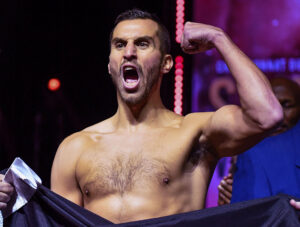Weeks of bad blood had simmered between former IBF middleweight world champion, David Lemieux, and Ireland’s Gary ‘Spike’ O’Sullivan leading up to their fight on the undercard of the Canelo-Golovkin HBO main event on Saturday night, fuelled by the exchange of insults and taunts on social media.
During fight week, it boiled over into a very public and distasteful display of trash-talking. Lemieux branded O’Sullivan a ‘woman beater’ in reference to the Cork man’s 2010 conviction for assaulting his former partner and professed a desire to inflict permanent damage on his opponent. For his part, O’Sullivan vowed to end Lemieux’s career, referring to him as a ‘scumbag’ and ‘greaseball’, amongst other unprintable labels.

Given the animosity between the two men and their reputations as knockout artists, an explosive encounter was heavily anticipated. Lemieux came out fast in the opening round, throwing every punch with bad intentions, including some vicious hooks upstairs and downstairs which his foe clearly felt.
O’Sullivan was far less busy, whether by dint of feeling Lemieux’s power early or biding his time to hit back with his own power punches. He did connect with a crisp jab which knocked back Lemieux momentarily but it only proved the prelude for the fight’s crushing conclusion. A picture-perfect Lemieux left-hook – his signature punch – connected flush with O’Sullivan’s jaw and sent the Irishman crashing to the canvas for the first time in his career. O’Sullivan struggled to his knees by the count of five but was clearly with the fairies, prompting the referee to call a halt to the contest.

It was the explosive ending which had been anticipated, but its emphatic nature, coming in the very first round, was nonetheless shocking. O’Sullivan entered the contest with a well-deserved reputation for durability, having eaten Chris Eubank Jr’s best shots without touching down in their 2015 encounter. Even Lemieux admitted during fight week that he was facing a ‘tough guy’ and that it might take a number of rounds to get his man out of there. 164 seconds was all it took in the end.
He may be crude and one-dimensional and had looked awful last year being routed by Billy Joe Saunders on home soil in Canada, but there is likely no middleweight on planet earth who packs as much single-punch-power as does Lemieux. Not Canelo Alvarez nor Danny Jacobs nor even former Lemieux-conqueror Gennady Golovkin. While Saunders’ slick southpaw style gave him nightmares, O’Sullivan, with his willingness to stand in front of his foe, was tailor-made for him.

At the same time, another factor was at play, one which attests to a malaise afflicting boxing that perhaps does not get treated with the seriousness that it deserves and is bound to divide opinion. Lemieux weighed inside the middleweight limit of 160 pounds, but by fight night had rehydrated to 179 pounds, over the light heavyweight limit.
In contrast, O’Sullivan only rehydrated to 164 pounds and thus entered the ring as a man fighting two weight divisions below Lemieux. The size disparity between the two men on fight night was starkly visible. That’s not to say it would have changed the outcome of the fight – Lemieux’s left-hook would have knocked out a horse – but it calls into question how a level playing field can be maintained under the current boxing regime of day-before weigh-ins.
This was introduced back in the early 1980s, ostensibly to protect boxers who would otherwise enter the ring in diminished physical condition, having drained themselves to make weight. In reality, monetary considerations, such as the financial loss to be incurred in the event of a fight being cancelled due to a fighter’s failure to make weight, reigned supreme in the minds of the boxing powers as they were then. If anything, they have become more prominent. Contemporary boxing weigh-ins are part and parcel of a fight’s promotion and hype, generating huge crowds, media publicity and additional riches for the interested parties.

Unfortunately, what is good for one’s pocket is not always good for one’s health. The rationale for boxing weight classes being introduced was to ensure parity of size between combatants and thus fairer contests. Day-before weigh-ins which permit boxers to rehydrate up to two weight divisions above their opponents by fight night reduce this point to irrelevance. And the bigger the size mismatch, the bigger the likelihood of tragedy occurring in the ring.
Joey Gamache, the former WBA super featherweight and lightweight world champion, can vouch for this as he was brutally knocked out and nearly lost his life in his 2000 bout with Arturo Gatti in which he was outweighed in the ring by 15 pounds – the same amount which Lemieux outweighed O’Sullivan by – but exacerbated by fighting at an even lighter weight.
Boxing has given us numerous other egregious examples of size mismatches in recent years; far too many to mention in a single article. It is true that Gamache suffered catastrophic, life-changing injuries while O’Sullivan will likely continue his boxing career having suffered no lasting effects from his knockout defeat. It is also true that while Gatti failed to make the contracted weight in that fight, Lemieux, by weighing inside the middleweight limit, played by the rules. It does not however make them any less flawed.
What about the original argument that day-before weigh-ins would lessen the health risks caused by depleting and dehydrating oneself before the fight? Nothing much has changed there. It anything, the measures taken by boxers and other adherents of combat sports in order to boil themselves down to as light a weight as possible for a contest have become more extreme.
American boxer Danny O’Connor recently withdrew from a world title fight against WBC light-welterweight champion Jose Ramirez suffering from dehydration and kidney failure as a result of trying to make weight. MMA star Khabib Nurmagomedov likewise had to be hospitalised last year due to a failed weight cut, causing a high-profile UFC bout with Tony Ferguson to be scrapped. As with the examples of size mismatches, the list goes on and on.

It is time for boxing to consider a return to same-day weigh ins. Day-before weigh-ins have patently failed to deliver when it comes to the health of combatants, simply offering us the worst of both worlds. One might argue that same-day weigh-ins would not deter boxers from attempting extreme and health-endangering weight cuts, with even more dire consequences to follow.
Call it boxing realpolitik if you want, I call it a glib point. I submit that they would actually give boxers the incentive to fight at their natural, healthy weights, which would also maximise athletic performance. Extreme weight-cutting practices might have increased since the early 1980s, but correspondingly so has understanding of their consequences for one’s health. If we are true supporters and followers of the sport, we should be encouraging participants to be health-conscious, responsible and professional.

A boxer who undertakes an extreme weight-cut knowing that he will fight on the same day he is weighed does not embody any of these qualities. Weight checks are already commonplace leading up to a fight and these should be maintained as part a policy of strict monitoring under a new same-day weigh-ins regime, for compliance purposes and as an additional safeguard.
For those on a slow learning curve, I’ll conclude by keeping it nice and simple. Is it really such an unreasonable aspiration to have, that boxers should fight at their natural, healthy weight against opponents of the same size?
Article by: Paul Lam
Follow Paul on Twitter at: @PaulTheWallLam